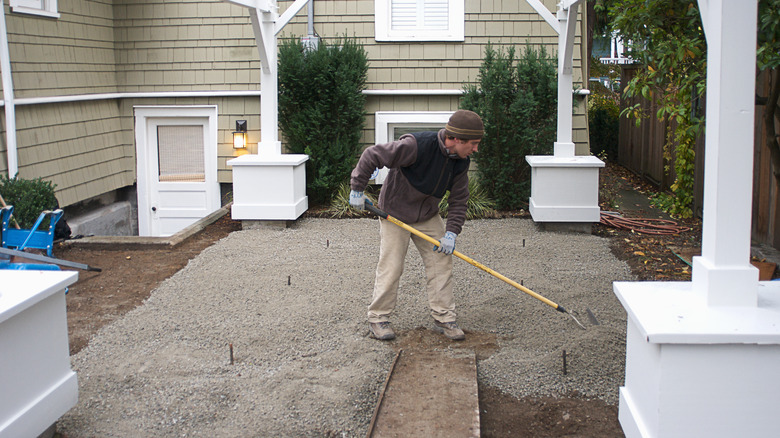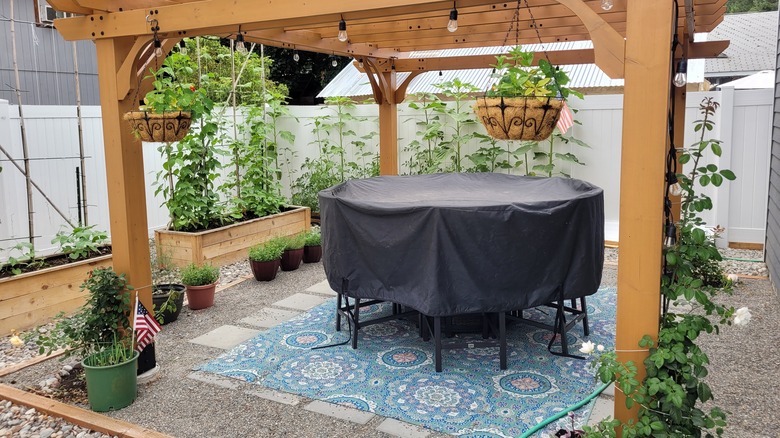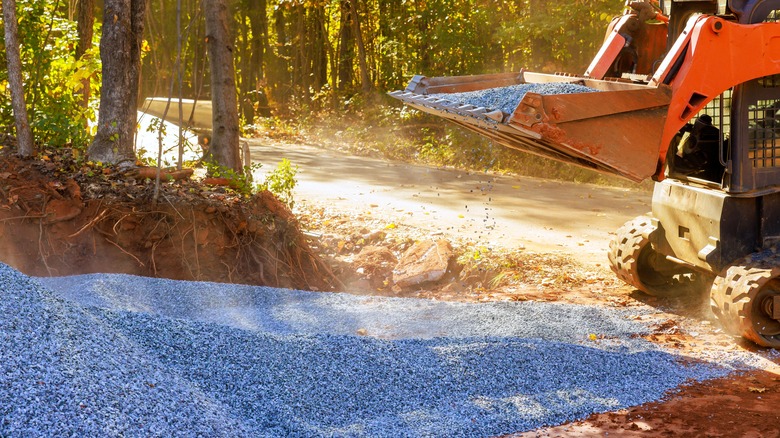The Different Uses Of Pea Gravel And Crushed Stone For Your Yard
Pea gravel and crushed stone are two types of rocks used in landscaping and construction, and their names are often used interchangeably in the industry. But these types of stone are quite different in almost every regard, including their origin, appearance, and utility. Crushed stone is a human-made aggregate that's produced by crushing big rocks into little rocks with the aid of a rock crusher — hence the name. On the other hand, pea gravel is not made by humans. It occurs naturally, and is typically shaped by flowing water and erosion, which gives it its smooth edges. In fact, looking at the edges of crushed stone and gravel offers the easiest way to tell the two stones apart. Unlike pea gravel, crushed stone has coarse, uneven edges. This key difference dictates the varying applications of both types of rock.
Thanks to its polished contours, pea gravel has much more visual appeal than crushed stone, and is easier to walk on. That's why it's most often used in surface applications. In your yard, you can install a pea gravel patio or walkway, or use the stones as mulching material that adds contrast to the garden beds. Meanwhile, the more jagged crushed stone usually winds up supporting the hardscaping elements we see and making them strong. You can use crushed stone as a base material for patios and driveways, as a permeable medium in drainage systems, and as aggregate in concrete slabs or walls. Below, we take a closer look at all the ways you can put pea gravel and crushed stone to use.
Different pea gravel uses in the yard
Unlike crushed stone, pea gravel has rounded edges — a quality that lends itself perfectly for walking, even without shoes. Thanks to this characteristic, along with its visually pleasing aesthetic, pea gravel is an excellent choice for creating walkways, patios, and even driveways. It can also be used as a hardscaping element that serves several functions. On one hand, pea gravel mulch offers an easy way to prevent weeds from germinating and spreading in your yard, all while allowing excellent drainage. On the other hand, pea gravel also creates visual barriers between garden beds and elevates the outdoor space with an injection of color and texture.
How you install pea gravel depends on the application. If you're building a pea gravel patio, driveway, or walkway, you'll first need to remove the topsoil and excavate to a half-foot depth. Then, it's always best to lay down a landscaping fabric barrier as an additional layer of defense against weeds. Next, add crushed stone followed by sand to create a sturdy base, and compact it using a tamper tool. Finally, mix the pea gravel with an epoxy-based landscaping adhesive and distribute it evenly throughout the space.
Using pea gravel as a mulch is much simpler. There's no need for landscaping fabric — in fact, you shouldn't use it beneath pea gravel when it functions as mulch. Just lay down 3 inches of the stuff, being sure not to cover the plants' crowns with the stones. Regardless of how you're using this type of stone in your yard, it's crucial to install edging to keep the pea gravel from washing away.
How to use crushed stone in your outdoor space
Whereas pea gravel has aesthetic value that landscapers often utilize, crushed stone plays a more practical role. For one, if you're paving a driveway or a patio, regardless of the surface materiality, crushed stone with stone dust is your go-to option. This type of crushed stone compacts quite well to ensure a stellar foundation for whatever ends up on the surface, and provides excellent drainage. Likewise, you'll turn to crushed stone to support sheds, slabs on grade, foundations, and virtually any other structure you erect in your yard. As a drainage material, crushed stone can help keep rainwater from accumulating around structures on your property if you use it in a system like a French drain.
Apart from this "supporting role," crushed stone is a key ingredient in concrete. That's because its sharp edges interlock well to create a robust base for the concrete when it cures. If you're pouring a new concrete driveway, a new slab for an accessory structure, or creating your own concrete pavers, it's almost inevitable that you'll use crushed stone as an aggregate.
Crushed stone comes in many different sizes, and the size you choose depends on the application. Generally, the largest stones are used as a base material under driveways, patios, and walkways. Meanwhile, medium-sized stones are preferred in drainage applications, while the smaller ones make their way into concrete. In concrete mixes, the heavier the loads the slab or wall will support, the larger the stones you'll have to use.


